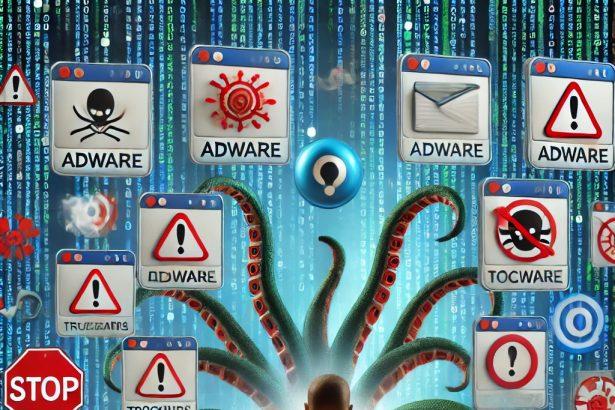The Ads by install-check.com adware disguises itself as a notification prompt. Once you’re tricked into allowing notifications, it bombards you with intrusive pop‑ups—fake warnings, dubious offers, and malicious redirects. Worse yet, downloading the suggested file on their site may lead to browser hijacking, adware infiltration, or even malware execution. Avoid granting any permissions to this site and act fast if you see its alerts.
Threat Summary
| Threat Type | Push notification spam, unwanted ads, intrusive pop‑ups |
|---|---|
| Detection Names | CyRadar (Malicious), Fortinet (Phishing), Google SafeBrowsing (Phishing), Seclookup (Malicious), Webroot (Malicious) |
| Symptoms | Random ads not tied to real sites, slow browsing, pop‑ups, redirects |
| Damage & Distribution | Slows performance, tracks your browsing, may lead to other malware; distributed via deceptive redirects, pop‑ups, false “Download” prompts, or suspicious apps |
| Danger Level | Moderate to high — persistent annoyance with potential for privacy risk or malware |
| Removal Tool → | SpyHunter |
How Ads by install‑check.com Affects Your Browser
Once you approve notifications from install‑check.com, your device becomes a persistent target for unwanted ads. Expect alerts about fake updates, offers, or warnings—each crafted to lure you into installing shady software or revealing sensitive info. Clicking any of these may result in redirects to untrustworthy pages, browser slowdowns, or deeper system compromises.
Where Ads by install‑check.com Comes From
This adware usually arrives through deceptive sites that use misleading “Allow to continue” buttons, or via rogue ad networks—including those on torrent, streaming, or questionable download sites. You might also encounter it from adware-laden apps or scam emails.
Is Ads by install‑check.com a Real Threat?
It’s not a virus—but it’s more than just annoying. This is a type of Potentially Unwanted Program (PUP), specifically notification spam combined with adware. It doesn’t directly infect files like traditional viruses, but it undermines your browsing experience, privacy, and can be an entry point to malicious software.
Manual Adware Removal Process (Windows & Mac)
Step 1: Identify and Uninstall Suspicious Applications
For Windows Users
- Open Task Manager by pressing
Ctrl + Shift + Esc. - Navigate to the “Processes” tab and search for unknown or high-resource-consuming processes.
- If you detect anything suspicious, right-click and select “End Task.”
- Go to
Control Panel>Programs>Programs and Features. - Locate and uninstall any unfamiliar programs.
For Mac Users
- Open
Finderand click onApplications. - Identify and move any suspicious applications to the
Trash. - Empty the
Trash. - Check
System Preferences>Users & Groups>Login Itemsfor unknown startup programs and remove them.
Step 2: Remove Malicious Browser Extensions
Google Chrome
- Open Chrome, click
Menu(three dots) >Extensions. - Locate and remove unknown extensions.
- Reset Chrome:
Settings>Reset settings> “Restore settings to their original defaults.”
Mozilla Firefox
- Click
Menu>Add-ons and themes. - Remove suspicious extensions.
- Reset Firefox:
Help>More troubleshooting information> “Refresh Firefox.”
Safari (Mac)
- Open Safari, go to
Preferences>Extensions. - Delete unknown extensions.
- Reset Safari:
History> “Clear History.”
Microsoft Edge
- Click
Menu>Extensions. - Remove any unfamiliar extensions.
- Reset Edge:
Settings>Reset settings> “Restore settings to their default values.”
Step 3: Delete Adware-Associated Files and Folders
For Windows Users
- Press
Win + R, type%AppData%, and press Enter. - Locate and delete suspicious folders.
- Repeat for
%LocalAppData%,%ProgramData%, and%Temp%.
For Mac Users
- Open Finder and press
Shift + Command + G, then enter~/Library/Application Support/. - Remove any suspicious folders.
- Repeat for
~/Library/LaunchAgents/,~/Library/LaunchDaemons/, and~/Library/Preferences/.
Step 4: Flush DNS Cache to Remove Adware Traces
For Windows Users
- Open
Command Promptas Administrator. - Type
ipconfig /flushdnsand press Enter.
For Mac Users
- Open
Terminal. - Enter
sudo killall -HUP mDNSResponderand press Enter.
Step 5: Restart Your System
Perform a reboot to apply the changes and ensure the removal process is complete.
Automatic Adware Removal Using SpyHunter (Windows & Mac)
For an effortless and effective solution, use SpyHunter, a powerful anti-malware tool designed to detect and remove adware completely.
Step 1: Download SpyHunter
Click the link to download SpyHunter: Download SpyHunter Here.
Step 2: Install SpyHunter
Follow the installation guide based on your operating system:
For Windows Users
- Run the downloaded
.exefile. - Follow the installation instructions.
- Launch SpyHunter and allow it to update its malware database.
For Mac Users
- Open the downloaded
.dmgfile. - Drag and drop SpyHunter into
Applications. - Open SpyHunter and let it update its database.
Step 3: Scan and Remove Adware
- Open SpyHunter.
- Click
Start Scan. - Wait for the scan to complete.
- Click
Fix Threatsto remove detected malware.
Step 4: Restart Your Computer
After SpyHunter removes all threats, restart your system to ensure all adware components are fully removed.
Conclusion
The Ads by install-check.com adware masquerades as something harmless but disrupts your browsing and threatens your privacy. By revoking notifications, cleaning suspicious components, resetting your browser, and using trusted security tools, you can regain control. Be cautious about websites asking for notification permission and never download files from unverified prompts.




